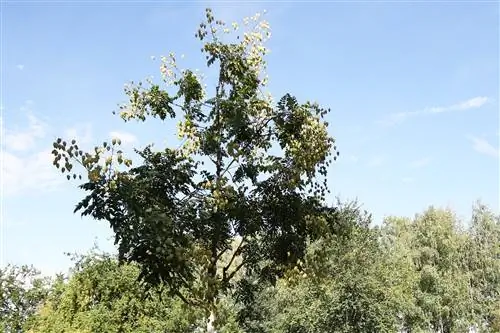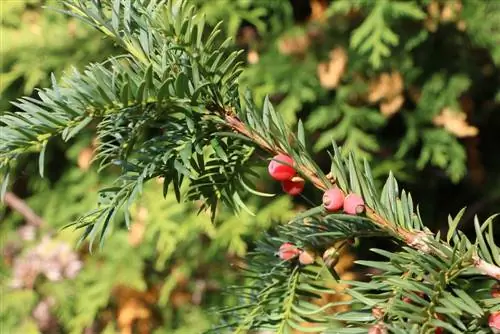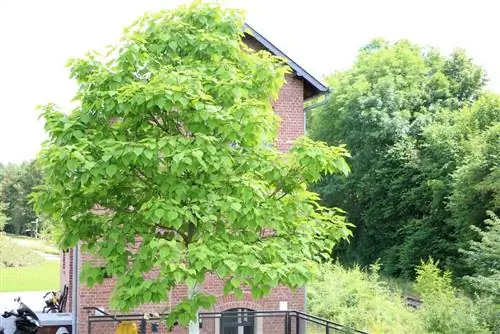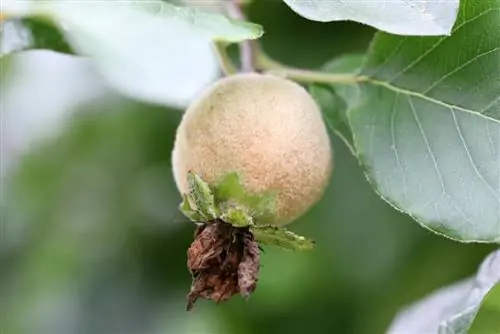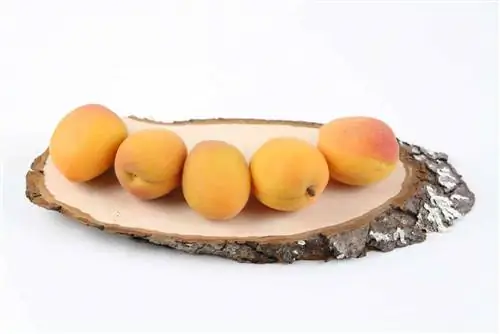- Author admin [email protected].
- Public 2023-12-17 03:39.
- Last modified 2025-01-24 12:45.
The bubble tree or Koelreuteria paniculata, as its botanical name is, is still a rarity as a garden plant. Thanks to its unusual growth and balloon-shaped fruits, it is a beautiful eye-catcher that also does well with little care. If it's the right one!
Select the correct location
The bubble tree prefers a sunny location, but is only partially heat-resistant. The chosen location should receive a lot of light but at least be protected from the blazing sun. The traveling shade of a house or other trees is ideal. If there is no protection whatsoever, direct shade should be provided, at least for young Koelreuteria paniculata. For example, through fleece, jute or an awning. Alternatively, young bladder trees can be cultivated in a pot for the first few years and moved if necessary.
Substrate
The bubble tree is extremely frugal when it comes to substrate. Poor, calcareous soils are optimal. They should be well-drained and loosened to the depth. A mixture of garden or pot soil and sand is already suitable. If you want to save yourself initial fertilization, you can add compost to this combination.
The culture in the bucket
Depending on the species, the bubble tree reaches a height of up to eight meters. However, the plant grows slowly and can therefore be cultivated in a pot, at least in the early years. However, the container you choose must be large enough to provide enough space for the roots.
Care
If the Koelreuteria paniculata is cultivated in a bucket, the care required is slightly higher. Even then, the bubble tree is a robust plant that can be left largely to its own devices. Only watering and fertilizing are required regularly during the warm months.
Pouring
Planted freely in the garden, the Koelreuteria paniculata quickly becomes self-sufficient. Additional watering is therefore only necessary if the summer is very dry. Of course, things are different when growing in a bucket; watering should always be carried out when the top layer of the substrate is completely dry. Normal tap water can be used as irrigation water, as the bladder tree tolerates lime well.
Fertilize
Although the bubble tree grows so slowly, it requires a comparatively large amount of nutrients in summer. However, this need should not be met by a gift. Instead, it is recommended to fertilize three to four times. And at intervals of six to eight weeks. This should begin at the end of March or beginning of April. The last fertilization should take place no later than August or early September. If this date is missed, it is better not to give nutrients. Because too many nutrients only mean that the bladder tree cannot adjust to the rest phase in winter in a timely manner and therefore becomes more susceptible to frost. Compost and inorganic mineral-based fertilizers are suitable as agents. It is particularly recommended to either mix them directly with each other or give them alternately. Afterwards, water abundantly so that the roots do not suffer burns.
Cutting
The care once again benefits from the fact that Koelreuteria paniculata grows rather slowly. Only 20 cm in height and around 15 cm in circumference can be expected per year. The waste can therefore be kept to a minimum and does not have to be done every year. If the tree is to be pruned, spring, specifically March or April, should be chosen. It is best to proceed gently and cautiously and to shorten the branches by a maximum of a quarter of their entire length. If you want to fully experience the natural shape of the bubble tree, you should only thin out areas that are too dense. Then the Koelreuteria paniculata initially takes on a spherical shape. Later the crown develops into an umbrella.
Wintering outdoors
Bubble trees can tolerate short-term drops in temperature of -15 °C, but are damaged if this condition lasts longer. Protection against the cold is therefore absolutely recommended. And should include the whole tree. For this purpose, plenty of autumn leaves are piled up in the area of the shallowly growing roots. A layer of straw, brushwood and mats or slats can follow. This layering makes sense especially when the winter gets very harsh. The crown should be wrapped in garden fleece. Other materials are less recommended because they do not allow enough light and air to pass through. At least during the first few years and for very old bubble trees, it also makes sense to wrap the trunk of the bubble tree with jute strips. On the one hand, these offer protection from strong sun, which can damage the bark, especially in winter. On the other hand, frost is kept away.
Tip:
Koelreuteria paniculata are at risk of late frost. As a result, the first shoots often freeze. However, that is no reason to worry. The bubble tree will quickly replace these, even without additional care.
Overwintering in a bucket
Bubble trees that are grown in containers should not overwinter outdoors. This is possible with sufficient protection, but on the one hand it is quite complex and on the other hand it can hardly be done without damaging the plant. So it is better to move the bubble tree indoors. Here it should of course be frost-free; 5 °C to 10 °C is ideal. Warmer and Koelreuteria paniculata does not go into the required winter rest. Colder and the tree suffers frostbite or dies completely. To do this, it is necessary to place the bucket in a bright place. Although the leaves are shed, the plant still needs light. Occasional, sparing watering is required.
Tip:
The ideal time to bring the bubble tree indoors is when temperatures are between 5 °C and 10 °C - around October. The bucket can go outside again when the last frost has passed.
What you should know about the bubble tree in brief
The bubble tree is an easy-care plant that impresses with its unique fruiting bodies, shape and bright coloring in autumn. Because the plant is easy to care for, it is even suitable for beginners in plant care. It blooms in midsummer with bright yellow flowers that grow in panicles up to 30 cm long. These flowers develop into capsules with seeds that look like lanterns.
Location and care
- Koelreuteria thrives best in a sunny spot in the garden, where it is somewhat sheltered from the wind.
- It is quite undemanding when it comes to soil conditions and does well even on nutrient-poor soil.
- It grows even better there than on humus-rich soils, so it's best not to fertilize it at all.
However, the lantern tree cannot tolerate soil that is too dense, so in this case the soil should be made a little more permeable with gravel or sand before planting. The water requirement of the lantern tree is moderate, so it usually only needs to be watered in very hot summers and otherwise gets by with rainwater. It usually survives short dry periods without any damage.
Cutting
- The bubble tree has a round crown in the first few years, which becomes umbrella-shaped in later years.
- It can grow up to ten meters high over the years, but grows slowly at 10 to 20 cm.
- A tree that has become too large over time can be cut back if necessary.
- However, it should be noted that the more a tree is shortened, the more it will sprout again.
- It is therefore advisable to shorten the branches and twigs only slightly in order to sustainably curb the growth of the tree.
Wintering
- The lantern tree can withstand temperatures down to -15° C and therefore does not need any protection against the cold in winter.
- However, when young, the ground around the trunk should be covered with a layer of leaves or mulch.
- The trunk is protected from strong winter sun by being wrapped with jute or other natural materials.
In a container, however, the roots of the tree are more at risk, so in this case the container should be wrapped with an insulating material or the entire plant should be overwintered in a frost-free room. This room can be dark, because the bubble tree sheds its leaves in autumn anyway and only needs a little light until the new shoots appear in spring.

